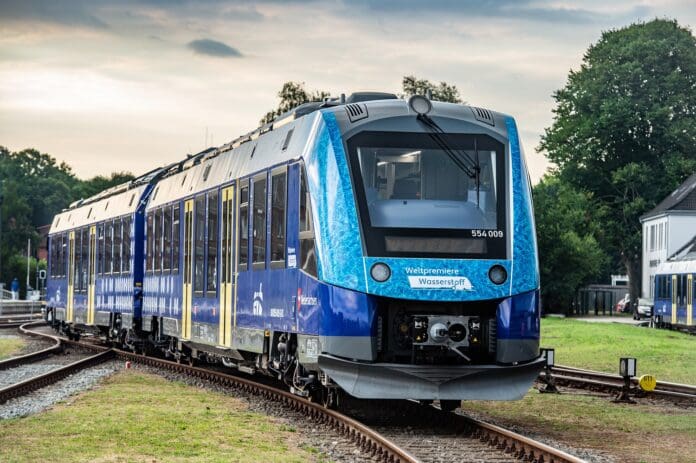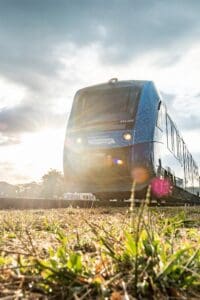
Germany is the undisputed leader when it comes to investing in the hydrogen economy. Hydrogen infrastructure and technology investment has received government support and interest from the business and environmental communities as well. Funding hydrogen production plants and investing in new technologies is good for the long-term future of the hydrogen economy. However, what Germany needs in the short-term are solutions that run on hydrogen to prove the fuel source can be economically and environmentally viable.
On August 24th, Germany’s hydrogen economy took a leap forward when French multinational transportation company, Alstom Group (Alstom), debuted 14 Coradia iLint hydrogen-powered trains in Bremervörde, Lower Saxony, Germany. What began as a pilot project four years ago has now turned into a viable source of clean transportation. The carbon dioxide (CO2) emissions-free trains produce little noise and emit steam and condensed water instead of harmful pollutants. “The 14 vehicles with fuel cell propulsion belong to Landesnahverkehrsgesellschaft Niedersachsen [LNVG],” said Alstom in a statement. “LNVG had already started looking for alternatives to diesel trains in 2012 and thus provided momentum for the development of the trains in Germany. Other project partners for this world debut are the Elbe-Weser railways and transport company [EVB] and the gas and engineering company Linde.”
According to Alstom, the Coradia iLint is the first passenger train that runs on a hydrogen fuel cell that generates electrical energy for propulsion. “The Coradia iLint features several innovations: clean energy conversion, flexible energy storage in batteries, and intelligent management of motive power and available energy. Specifically developed for use on non-electrified lines, it enables clean, sustainable train operation while maintaining high performance,” said Alstom in a statement.
The Coradia iLint was designed and developed by Alstom’s center of excellence for regional trains in Salzgitter, Lower Saxony, Germany, and at its center of excellence for traction systems in Tarbes, France. The Coradia iLint received federal funding from Germany’s National Innovation Programme for Hydrogen and Fuel Cell Technology. The Coradia iLint also won the 2022 German Sustainability Design Award, which recognizes technical and social solutions that are particularly effective in driving the transformation to sustainable products, production, consumption, or lifestyle in line with the United Nations’ 2030 Agenda.
“Emissions-free mobility is one of the most important goals for ensuring a sustainable future and Alstom has a clear ambition to become the world leader in alternative propulsion systems for rail,” said Henri Poupart-Lafarge, CEO and chair of Alstom. “The world’s first hydrogen train, the Coradia iLint, demonstrates our clear commitment to green mobility combined with state-of-the-art technology. We are very proud to bring this technology into series operation as part of a world premiere, together with our great partners.”
From Diesel To Hydrogen
According to Alstom, each hydrogen-powered train has a maximum speed of 87 miles per hour (140 km per hour) but tends to run at an average speed of 50 to 75 miles per hour (80 to 120 km per hour). Each train has a range of 621 miles (1000 km) and can therefore run on just one tank of hydrogen per day on the EVB network. The long range reduces the strain of fueling at the Linde hydrogen filling station. Over time, the 14 hydrogen-powered trains will replace the 15 diesel-powered trains currently in operation on the Bremervörde segment of the EVB network.
Germany operates more than 4000 diesel rail cars, indicating hydrogen trains have a long way to go if they want to make a meaningful impact on decarbonizing Germany’s rail network. “Alstom currently has four contracts for hydrogen fuel cell-powered regional trains,” said the company in a statement. “Two are in Germany, the first for 14 Coradia iLint trains in the region of Lower Saxony, and the second for 27 Coradia iLint trains in the Frankfurt metropolitan area. The third contract comes from Italy where Alstom is building six Coradia Stream hydrogen trains in the region of Lombardy — with the option for eight more, while the fourth is in France for 12 Coradia Polyvalent hydrogen trains shared across four different French regions. Furthermore, the Coradia iLint has been successfully tested in Austria, the Netherlands, Poland, and Sweden to name a few.”

The Hydrogen Filling Station
Running the Coradia iLint trains would not have been possible without prior hydrogen investments. Germany currently has more than 100 hydrogen fueling stations, but plans to have at least 300 stations by 2030. However, constructing a hydrogen filling station for a passenger hydrogen train is a much more complicated task.
In July 2020, Linde announced it was building the first hydrogen refueling station for passenger trains. At the time, Alstom’s pilot project was coming closer to a reality, but the company needed reliable and safe fueling. Linde has spent the last two years constructing the station. Initially, the hydrogen filling capacity had a planned capacity of 3527 lb. (1600 kg) per day. Over time, the project grew in scope and now has 3968 lb. (1800 kg) per day of storage capacity. The station is one of the largest hydrogen filling stations in the world. In total, it contains 64 high-pressure storage tanks that operate at 7252 psi (500 bar), six hydrogen compressors, and two fuel pumps. According to Alstom, one kilogram of hydrogen can replace roughly 4.5 liters of diesel fuel. Alstom also noted that the site includes opportunity to expand electrolysis capacity and increase the size of the filling station.
The station will be supplied by Alstom to the regional traffic provider, LNVG, and will use EVB’s existing rail infrastructure. The station complements Linde’s global network of more than 180 hydrogen fueling stations and 80 hydrogen electrolysis plants. All told, Linde has the largest liquid hydrogen capacity and distribution system in the world.
Federal Funding Proves Essential For Project Development
Germany’s Federal Ministry of Digital Affairs and Transport helped fund the project as part of the National Hydrogen and Fuel Cell Technology Innovation Programme. The funding directive is coordinated by NOW GmbH and implemented by Project Management Jülich (PtJ). All told, Germany’s federal government contributed US$12.63 million to the project, with around US$8.35 million going directly toward the cost of the vehicles and US$4.28 million allocated toward the filling station.
















